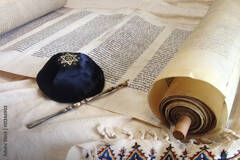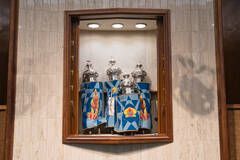B'rit Milah & Baby Naming
According to traditional Jewish practice, on the eighth day after a boy is born, he is circumcised, and several blessings are recited. This ritual, called B'rit Milah (commonly known as a Bris), was first mentioned in the Torah, when God said, “Every male among you shall be circumcised… it shall be a sign of the covenant between Me and you” (Genesis 17:11). The B'rit Milah may be postponed, however, if the child is not healthy enough to undergo the procedure.
A B'rit Milah is typically performed by a mohel, who is a Jew trained in religious law and surgical techniques. Some families choose to use a pediatric surgeon to perform the circumcision and have a rabbi or cantor lead a ritual to commemorate the bris. The B'rit Milah may occur in any location that will allow it, and usually occurs in the parents’ home or a synagogue.
While there is no comparable ceremony for baby girls, the birth of a baby girl is often celebrated with a baby naming ceremony or B'rit Bat. Blessing are said during the ceremony acknowledging that the child has been entered into a b'rit, a covenant, with God. Blessings are also recited for the baby's well-being. The traditional wish is offered - that this child may grow into a life of study of Torah, of loving relationships, and the performance of good deeds.
Bar/Bat Mitzvah
Jewish tradition has established an age when young people become eligible to participate in certain aspects of Jewish religious life, and obligated to fulfill mitzvoth (sacred obligations) that are incumbent upon Jewish adults. This age is traditionally 13 years old for a boy and 12 ½ for a girl – though Reform Judaism has generally been consistent at 13 as the age of religious maturity.
|
Upon reaching the age of 13, for example, the young person becomes eligible to read from the Torah, or be called to the Torah to recite the blessings when the Torah is read. An example of obligation, for those who follow this tradition, would be fasting on Yom Kippur, which becomes obligatory at the age of 13. A bar mitzvah (male) or bat mitzvah (female) is therefore not an event, but a status: one becomes bar or bat mitzvah, which literally means subject to the system of mitzvot, religious obligations. At Temple Beth Or, candidates for bar/bat mitzvah begin their studies with the rabbi about one year prior to their bar/bat mitzvah service. Ideally, candidates should be relatively comfortable with reading basic Hebrew before meeting with the rabbi, though other arrangements can be made as necessary. During this year of private study, the students learn to read a passage from Torah and a passage from a prophetic reading [Haftarah], along with the accompanying blessings, and to lead prayers from the Siddur. Students also undertake a mitzvah project, and prepare a D’var Torah (Torah-based sermon). There is no maximum age to celebrate a bar/bat mitzvah with a special service. Though one becomes eligible at 13, adults of any age who might not have had the experience of reading Torah and leading worship can have a bar/bat mitzvah service. Sometimes a group of adults will study together, and their group experience can lead to a very moving service as they finish their studies.
|
B’nei Mitzvah Resources
The Art of Torah Cantillation – A Step-by-Step Guide to Chanting Torah by Cantor Marshall Portnoy and Cantor Josee Wolff This unique, step-by-step book and compact disc package will lead the novice through each step of learning how to chant Torah. Divided into 13 lessons and additional useful appendices and bibliography, the book allows the reader to ‘self-teach’ the important principles of Torah cantillation. The only pre-requisite for this course of learning is a basic ability to read Hebrew and a willingness to learn! Includes CD of corresponding recordings. Making it Count: Guidelines for Becoming a Bar/Bat Mitzvah This guide is designed to help you make the most of your Jewish journey. Focusing on the values that are most important in our tradition, you will explore together what commitments you can make to bring these principles to life. Judaism has a lot of special wisdom to offer, but only you can make it real. |
Marriage
Following adolescence, Judaism perceives that the next great stage of life is marriage. The decision to leave one’s parental home and to share one’s life with another, in love and respect, is seen to be critical to the ongoing success and continuity of the Jewish people. To enter this state, Judaism provides a series of rituals and ceremonies.
This ceremony takes place beneath a chuppah, which is a canopy representing the new home of the bride (kallah) and groom (chatan). The wedding ceremony often takes place inside a synagogue, but other popular locations are hotels, homes and parks. Many religious couples deliberately choose to be married outside, under the sky so to speak, since the number of stars in the sky are said to represent the future fruitfulness of the couple.
Prior to the ceremony, the chatan authorizes two witnesses to sign the marriage document, known as the ketubah. Traditionally the chatan is then led to where the kallah is waiting and he lowers her veil over her face as a sign of the modesty expected from a married woman. This ceremony, which also includes a poignant blessing from father to daughter as she embarks on married life, is known as bedeken. Some also consider that the purpose of this ceremony is so that the chatan may check the identity of his future wife and not make the same mistake as Jacob who married Leah instead of Rachel because her face was covered and he could not see her true identity.
Soon after these rituals are completed the various parties to the wedding find themselves beneath the chuppah. A series of blessings are recited, the rabbi gives a short address, the wedding ring is handed over, the ketubah is read out, more blessings are said and a glass is broken to remind everyone present that in spite of the joy of the moment, Jewish history in general and the history of Jerusalem in particular have contained many sad moments. The priestly blessing is then recited and following a brief interlude when bride and groom share time alone with each other, all the participants and their guests make their way to the reception at which eating and drinking, singing and dancing, speeches and toasts are the order of the day.
Death and Mourning
In Judaism the deceased is buried as soon as possible. Observant Jews of all branches of Judaism do not cremate, but cremation is increasingly popular with secular Jews (although preferring burial to cremation, Reform and Conservative Judaism do allow their rabbis to officiate at funerals where the deceased will be cremated; in contrast, Orthodox rabbis will not officiate at such funerals). At the funeral, each member of the immediate family, makes a short tear in one of their garments. This action, known as k’riah, symbolizes the way the death has torn, or broken, their heart.
During the funeral, Kaddish is recited for the first time. Mourners say this prayer, a praise of God, for the next eleven months if it is their parent who has died. Many mourners make an extraordinary effort to go to synagogue regularly during this time since this prayer can only be said in the company of a minyan (ten Jewish men over the age of Bar Mitzvah in Orthodox Judaism; ten Jewish adults – over Bar or Bat Mitzvah age – in Reform and Conservative Judaism).
After the funeral, the mourners return home and share a meal of condolence together.
Jewish tradition divides mourning into three successive periods which structure the mourners’ lives and help them to gradually and gently return to the activities of life and work.
- Shiva (7): The first period is the seven-day Shiva period, when the mourners abstain from all work and sit together at home receiving visitors who provide company and consolation. Friends and neighbors provide meals and take care of day-to-day tasks for the mourners. During this intense week of mourning, bathing, shaving, haircuts, marital relations and the wearing of leather shoes are forbidden.
- Sh’loshim (30): Following shiva, up until the end of thirty days counting from the burial, the mourners may return to work, but they abstain from most forms of entertainment, such as concerts, parties and movies. Many continue to avoid having a haircut or even a shave during this time. When mourning a relative other than a parent, formal mourning ends at the end of the Shloshim period.
- Yud-Bet Chodesh (12 months): From the end of sheloshim until a year of mourning has passed, the children of the deceased avoid joyous activities, especially music and parties. This 12 month period is observed only for a parent who has died and not for other relatives.
Besides this first difficult year, Judaism impresses on us the need to remember and respect the memory of our departed relatives. We do this by lighting a candle on the anniversary of their death each year. This anniversary is known as the Yahrzeit. The candle burns at home for 24 hours and Kaddish is recited in synagogue on that day.
A further ceremony is known as Yizkor. This includes a prayer commencing with the word Yizkor (meaning “May God remember the soul of ……”) and is done in synagogue four times a year on major festivals. Custom requires all those with a parent who has died to attend Yizkor and doing so is seen as a way of showing honor to one’s parent (the 5th of the 10 Commandments) even though they have died.
Finally, we are instructed to cover the grave with a stone. We read that Jacob set up a marker over Rachel’s grave (Genesis 35:20). Jewish graves are marked with the name of the deceased. Rabban Gamaliel’s instructions for burial emphasized equality and simplicity and thus large, ornate stone markers are discouraged. His son, Rabbi Shimon ben Gamaliel is quoted in an early rabbinic work as saying, “We need not erect monuments for the righteous; their accomplishments are their memorials.” The gravestone (called a matzevah in Hebrew) is erected during the first year after the death, usually towards the end of the year, and a religious ceremony called a “consecration” is held at the graveside to dedicate the gravestone in the deceased’s memory and honor.


